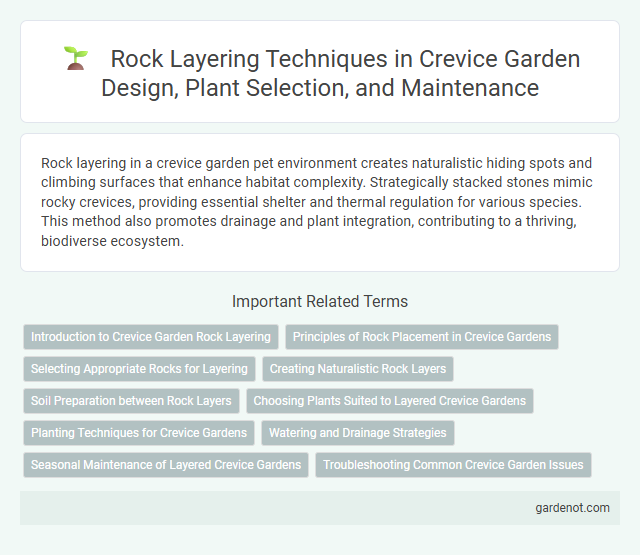Rock layering in a crevice garden pet environment creates naturalistic hiding spots and climbing surfaces that enhance habitat complexity. Strategically stacked stones mimic rocky crevices, providing essential shelter and thermal regulation for various species. This method also promotes drainage and plant integration, contributing to a thriving, biodiverse ecosystem.
Introduction to Crevice Garden Rock Layering
Crevice garden rock layering involves stacking narrow, vertical rocks closely together to create deep, well-drained spaces ideal for alpine and drought-tolerant plants. This technique mimics natural rock fissures, allowing roots to penetrate and anchor securely while maximizing air circulation and moisture control. Proper layering requires selecting durable, diverse stone sizes to enhance stability and aesthetic appeal in the crevice garden environment.
Principles of Rock Placement in Crevice Gardens
Rock layering in crevice gardens emphasizes stability, drainage, and aesthetics, using flat stones placed with natural angles to mimic geological formations. Principles of rock placement prioritize creating deep, narrow crevices between stones to accommodate alpine plants' root systems, ensuring proper water flow and preventing soil erosion. Selecting diverse rock sizes and textures enhances microclimates, supporting plant diversity and long-term ecosystem balance.
Selecting Appropriate Rocks for Layering
Selecting appropriate rocks for crevice garden layering involves choosing stones with varied sizes, textures, and colors to create natural-looking crevices that support diverse plant growth. Durable and weather-resistant rocks such as granite, limestone, and sandstone provide structural stability and promote proper drainage. Positioning larger rocks at the base enhances foundation strength, while smaller rocks fill gaps to simulate natural rock formations essential for alpine and drought-tolerant plants.
Creating Naturalistic Rock Layers
Creating naturalistic rock layers in a crevice garden involves carefully selecting and positioning stones to mimic natural geological formations. Use various sizes and shapes of rocks, placing larger stones at the base and gradually layering smaller rocks above to enhance stability and visual depth. Incorporate gaps and crevices to provide microhabitats for alpine plants, promoting biodiversity and authentic rugged aesthetics.
Soil Preparation between Rock Layers
Proper soil preparation between rock layers in a crevice garden ensures optimal drainage and root aeration, crucial for plant health. A well-draining soil mix, typically comprising sandy loam, compost, and grit, prevents waterlogging while retaining sufficient moisture. Layering soil carefully within crevices encourages deep root growth and mimics natural alpine environments.
Choosing Plants Suited to Layered Crevice Gardens
Selecting plants for layered crevice gardens requires emphasizing species with shallow root systems that thrive in narrow, rocky spaces. Drought-tolerant succulents, alpine plants, and rock garden perennials such as Sedum, Sempervivum, and Saxifraga excel in these environments due to their ability to anchor securely and access limited nutrients. Incorporating native species enhances ecological adaptation and ensures robust growth within the microhabitats created by rock layering.
Planting Techniques for Crevice Gardens
Rock layering in crevice gardens involves stacking flat stones vertically with narrow, deep fissures that mimic natural cliff environments, optimizing root penetration and drainage. Planting techniques emphasize selecting drought-tolerant alpine plants with fine, fibrous roots, carefully inserting them into tight crevices to ensure stability and moisture retention. Maintaining a balance between shade and sun exposure within the rock layers enhances plant health and supports diverse microhabitats in crevice gardens.
Watering and Drainage Strategies
Effective rock layering in crevice gardens enhances natural drainage by allowing water to flow through narrow gaps between stones, preventing root rot and waterlogging. Incorporating coarse gravel or sand beneath larger rocks improves soil aeration and directs excess moisture away from plant roots. Strategic placement of rocks combined with deep, infrequent watering promotes healthy root development and mimics native alpine conditions.
Seasonal Maintenance of Layered Crevice Gardens
Seasonal maintenance of layered crevice gardens involves carefully removing debris and dead plant material to ensure proper airflow and prevent fungal growth among rock layers. Inspecting and replenishing soil or grit between rocks helps maintain drainage and root stability for alpine plants. Regularly checking for erosion or displacement preserves the structural integrity essential for the garden's microhabitats.
Troubleshooting Common Crevice Garden Issues
Rock layering in crevice gardens requires precise placement to ensure proper drainage and root penetration, preventing waterlogging and plant stress. Troubleshooting common issues involves checking for poor soil compaction, uneven rock distribution, or blocked drainage paths that can cause root rot or hinder growth. Regularly inspecting layers and adjusting rock alignment promotes optimal aeration and moisture balance, enhancing plant health and longevity.
Rock layering Infographic

 gardenot.com
gardenot.com